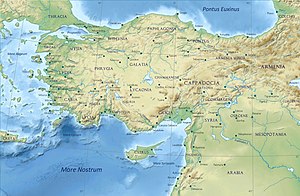Mysia(UK/ˈmɪsiə/,US/ˈmɪʒə/or/ˈmiːʒə/;Greek:Μυσία;Latin:Mysia;Turkish:Misya) was aregionin the northwest of ancient Asia Minor[1](Anatolia,Asian part of modernTurkey). It was located on the south coast of theSea of Marmara.It was bounded byBithyniaon the east,Phrygiaon the southeast,Lydiaon the south,Aeolison the southwest,Troadon the west, and thePropontison the north. In ancient times it was inhabited by theMysians,Phrygians,AeolianGreeksand other groups.
| Mysia | |
|---|---|
| Ancient Region of Anatolia | |
 Acropolis of Pergamon | |
| Location | North-westernAnatolia |
| Largest city | Pergamon |
| Inhabitants | Mysians |
| Language | Mysian |
| Achaemenidsatrapy | Phrygia |
| Roman province | Asia |
 | |
Geography
editThe precise limits of Mysia are difficult to assign. The Phrygian frontier was fluctuating, while in the northwest theTroadwas only sometimes included in Mysia.[1]The northern portion was known as "Lesser Phrygia" or (Ancient Greek:μικρὰ Φρυγία,romanized:mikra Phrygia;Latin:Phrygia Minor), while the southern was called "Greater Phrygia" or "Pergamene Phrygia". Mysia was in later times also known asHellespontine Phrygia(Ancient Greek:Ἑλλησποντιακὴ Φρυγία,romanized:Hellespontiake Phrygia;Latin:Phrygia Hellespontica) or "Acquired Phrygia" (Ancient Greek:ἐπίκτητος Φρυγία,romanized:epiktetos Phrygia;Latin:Phrygia Epictetus), so named when the region was annexed to theAttalid kingdom.[2]
UnderAugustus,Mysia occupied the whole of the northwest corner of Asia Minor, between theHellespontand thePropontisto the north,BithyniaandPhrygiato the east,Lydiato the south, and theAegean Seato the west.[3]
Land and elevation
editThe chief physical features of Mysia are the twomountains—Mount Olympusat (7600 ft) in the north and Mount Temnus in the south, which for some distance separates Mysia fromLydiaand afterwards prolonged through Mysia to the neighbourhood of the Gulf of Adramyttium. The major rivers in the northern part of the province are theMacestusand its tributary theRhyndacus,both of which rise inPhrygiaand, after diverging widely through Mysia, unite their waters below the lake ofApolloniatisabout 15 miles (24 km) from the Propontis. TheCaïcusin the south rises in Temnus, and from thence flows westward to theAegean Sea,passing within a few miles ofPergamon.In the northern portion of the province are two considerable lakes, Artynia or Apolloniatis (Abulliont Geul) and Aphnitis (Maniyas Geul), which discharge their waters into the Macestus from the east and west respectively.[1]
Cities
editThe most important cities were Pergamon in the valley of theCaïcus,andCyzicuson thePropontis.The whole sea-coast was studded with Greek towns, several of which were places of considerable importance; thus the northern portion includedParium,LampsacusandAbydos,and the southernAssos,Adramyttium.Further south, on the Eleatic Gulf, wereElaea,MyrinaandCyme.[1]
History
editA minor episode in theTrojan Warcycle inGreek mythologyhas the Greek fleet land at Mysia, mistaking it forTroy.Achilleswounds their king,Telephus,after he slays a Greek; Telephus later pleads with Achilles to heal the wound. This coastal region ruled by Telephus is alternatively named "Teuthrania" in Greek mythology, as it was previously ruled by KingTeuthras.In theIliad,Homerrepresents the Mysians as allies of Troy, with the Mysian forces led byEnnomus(a prophet) andChromius,sons ofArsinous.Homeric Mysia appears to have been much smaller in extent than historical Mysia, and did not extend north to the Hellespont or the Propontis.Homerdoes not mention any cities or landmarks in Mysia, and it is not clear exactly where Homeric Mysia was situated, although it was probably[original research?]located somewhere between theTroad(to the northwest of Mysia) and Lydia/Maeonia (to its south).
A number of Mysian inscriptions have survived in a dialect of thePhrygian language,written using a variant of thePhrygian alphabet.There are also a small number of references to aLutescan languageindigenous to Mysia inAeolic Greeksources.[4]
Under the PersianAchaemenid Empire,the northwest corner of Asia Minor, still occupied by Phrygians but mainly byAeolians,was called "Phrygia Minor" – and by the Greeks "Hellespontos".
After Rome's defeat ofAntiochus the Greatin theRoman-Syrian Warof 192 to 188 BC, the area, which had been held by theDiadochSeleucid Empire,passed to Rome's ally, theAttalid kingdom,and, on the death of KingAttalus IIIin 133 BC, to Rome itself, which made it part of theprovince of Asia[1]and, later, a separate proconsularRoman province,called "Hellespontus".[3]
According to theActs of the Apostles,[5]the apostlesPaul,SilasandTimothycame to (or passed by)[6]Mysia during Paul's secondmissionary journey.The narrative suggests that they were uncertain where to travel during this part of the journey, being "forbidden by the Holy Spirit to preach the word inAsia".[7] Shortly afterwards Paul had a vision of a "man of Macedonia"who invited the apostles to travel westwards toMacedonia.
Ancient bridges
editThe remains of severalRoman bridgescan still be found:
- Aesepus Bridgeacross theAesepus(todayGönen Çayı)
- Constantine's Bridgeacross theRhyndacus(Adırnas Çayı)
- Makestos Bridgeacross theMakestos(Susurluk Çayı)
- White Bridgeacross theGranicus(Biga Çayı)
See also
editReferences
edit- ^abcdeOne or more of the preceding sentences incorporates text from a publication now in thepublic domain:Hasluck, Frederick William (1911). "Mysia".InChisholm, Hugh(ed.).Encyclopædia Britannica.Vol. 19 (11th ed.). Cambridge University Press. pp. 115–116.
- ^Strabo,Geographia,XII.5.3
- ^abWilliam Smith,New Classical Dictionary of Biography, Mythology, and Geography,entry: "Mysia"
- ^Titchener, J.B. (1926),Synopsis of Greek and Roman Civilization,Cambridge MA
- ^Acts 16:7–8
- ^Acts 16:7 statesGreek:ελθοντες κατα την μυσιαν,'to Mysia' in mostEnglish translations,whereas Acts 16:8 statesGreek:παρελθοντες δε την μυσιαν,generally translated 'passing by Mysia' and in some cases 'bypassing Mysia', e.g.Holman Christian Standard Bible;all references taken fromBibleGateway.comaccessed 23 September 2015
- ^ Acts 16:6
External links
editMedia related toMysiaat Wikimedia Commons